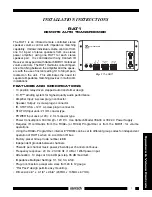
90
SD Series Technical Manual
MDS 05-4846A01, Rev. F
Intrusive vs. Passive (Non-Intrusive) Mode
Firmware code may be transmitted to stations in either intrusive or pas-
sive (non-intrusive) mode using the built-in diagnostic capabilities of
the radio. When OTA reprogramming is initiated from either a root or
node the firmware image is broadcast to
all
Remotes in intrusive or pas-
sive use of the channel.
Intrusive
operation means that the payload application data will be
interrupted while programming data is sent over the air. This is the
fastest method of programming radios over the air, but it comes at the
cost of interruptions in the primary use of the radio network. See
Table 17 for the approximate times needed for intrusive reprogram-
ming.
NOTE:
Intrusive mode should be used only when the radio channel
can be devoted to the reprogramming operation, as payload
data will be interrupted.
Passive (Non-intrusive)
operation “piggy-backs” reprogramming data
onto normal payload data streams, thus allowing payload data to con-
tinue uninterrupted. This mode requires payload data to be sent so that
the reprogramming data can be carried.
NOTE:
Radio networks configured for Packet w/MAC operation
support intrusive operation while still sending payload data.
Data is sent at the first chance, and does not wait for user data
to be sent.
Table 17. Approximate Reprogramming Times—
Intrusive Mode
Modem Speed
(bps)
Approximate Time Required
4800
1 hour, 30 minutes
9600
35-40 minutes
19200
20-25 minutes
Radio assumptions: Signal strength -85 dBm or
stronger, Packet Size: 40, Block Size: 512, Retry: 3
Polling assumptions: Serial polling with 1-second poll
time, sending random data at 50-100 bytes. Slower
polling times will significantly increase completion time.
Polling should be temporarily suspended while OTA
reprogramming is active.
















































